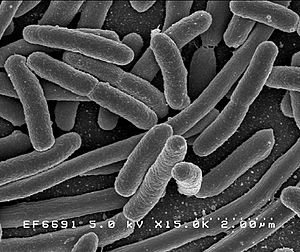Anaerobic respiration facts for kids
Anaerobic respiration is a way for living things to get energy without using oxygen. It's like a special power source for tiny organisms that live where there isn't much air. Instead of oxygen, they use other chemicals to help them make energy.
These chemicals can be things like nitrates, iron, sulfates, or even carbon dioxide. For example, a common type of bacteria called Escherichia coli (or E. coli) uses nitrates and fumaric acid to breathe and get energy.
How Does it Work?
All living things need to move tiny particles called electrons to make energy. This happens in something called an electron transport chain. Think of it like a tiny assembly line inside a cell. At the very end of this line, there needs to be something to catch the electrons. This "catcher" is called the final electron acceptor.
In humans and many other animals, oxygen is the catcher. Oxygen is very good at this job. But for organisms that do anaerobic respiration, other chemicals do the catching. These catchers, like sulfate or nitrate, don't work quite as well as oxygen.
Because these other chemicals aren't as good at catching electrons, less energy is made. This means anaerobic respiration is usually less efficient than aerobic respiration (which uses oxygen). It's like getting less power from the same amount of fuel.
Anaerobic Respiration vs. Fermentation
Sometimes, if an organism doesn't use oxygen at all, the process is called fermentation. Fermentation is a simpler way to make energy without oxygen.
- Lactic acid bacteria use fermentation. They are what make milk turn into yogurt.
- Yeast also uses fermentation. Yeast is a type of fungi, not bacteria. It helps make bread rise and can also make alcoholic drinks.
The Equation
One common example of anaerobic respiration, especially in muscles during intense exercise, is when glucose turns into lactic acid.
- glucose → lactic acid
- C6H12O6 → 2C3H6O3
See also
 In Spanish: Respiración anaerobia para niños
In Spanish: Respiración anaerobia para niños


